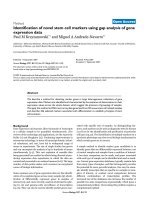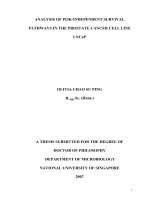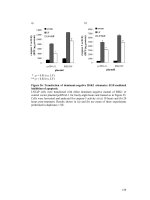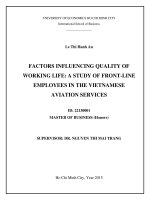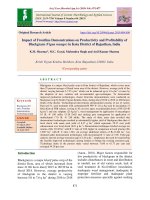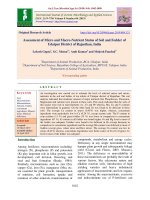Yield gap analysis of soybean through front line demonstrations in Pratapgarh: A tribal district of Rajasthan, India
Bạn đang xem bản rút gọn của tài liệu. Xem và tải ngay bản đầy đủ của tài liệu tại đây (157.56 KB, 4 trang )
Int.J.Curr.Microbiol.App.Sci (2019) 8(4): 1020-1023
International Journal of Current Microbiology and Applied Sciences
ISSN: 2319-7706 Volume 8 Number 04 (2019)
Journal homepage:
Original Research Article
/>
Yield Gap Analysis of Soybean through Front Line Demonstrations in
Pratapgarh: A Tribal District of Rajasthan, India
Yogesh Kanojia*, Harish Chandra Singh and R.K. Damor
Krishi Vigyan Kendra, Pratapgarh, Rajasthan, India
*Corresponding author
ABSTRACT
Keywords
Front line
demonstration,
Technology gap,
Technology index
Article Info
Accepted:
10 March 2019
Available Online:
10 April 2019
Front line demonstration is an effective and appropriate tool to demonstrate recommended
technologies among the farmers. Krishi Vigyan Kendra, Pratapgarh (Rajasthan) conducted
482 demonstrations on soybean from 2013 to 2017 in eight adopted villages. The critical
inputs were identified in existing production technology through farmers meeting and
group discussion with the farmers. The five years data revealed that an average yield of
demonstration plot was obtained 15.16 q/ha over local check (13.06 q/ha) with an
additional yield of 2.1 q/ha and average soybean productivity increased by 16.56%. The
average technology gap and technology index were observed 4.84 q/ha and 24.20%
respectively.
Introduction
India is the fourth largest producer of oilseed
and fifth largest producer of soybean in the
world. Now a days, soybean is major oil seed
crop of India. In India share of soybean in
total oilseed is about 25%. The continuous
increase in import of oilseed and oil is a
matter of great concern in Indian oilseed
scenario. In India during the year 2017-18
total area under soybean was 17.42 million
hectare and production was 20.68 million
tonnes with the productivity of 1187 kg per
hectare. In Pratapgarh district area under
soybean crop is increasing every year. The
area under soybean cultivation in state was
886487 hectares and the production was
1069830 tonnes with the productivity of 1207
kg/ha (2017-18). Soybean crop having highest
acreage in Kharif season in the district but
large yield gap exist between potential yield
and yield under real farming situations.
Pratapgarh district is situated in southern part
of Rajasthan. About 70% population of the
district is tribal and economic condition of
farmers is also limiting factor for soybean
cultivation. Soybean is major kharif crop of
the district. The area under crop in district is
129545 hectare and production is 154689
tonnes with the productivity of 1194 kg/ha
(2017-18). The poor productivity is because
of resource poor farmers are very reluctant
towards scientific management of crops.
1020
Int.J.Curr.Microbiol.App.Sci (2019) 8(4): 1020-1023
Percent increase yield= (Demonstration yield
- farmers yield)/ farmers yield X 100
Materials and Methods
The study was carried by the KVK,
Pratapgarh during Kharif season 2013 to 2017
(five consecutive years) at the farmers field of
eight adopted villages (Jhakar, Devgarh,
Motikhedi, Lalpura, Samli Pathar, Mota
Mayanga, Jawahar Nagar & Mandkalan) of
Pratapgarh district. During this five year of
study an area of 192.5 ha was covered with
plot size 0.4 ha under front line
Demonstration with active participation of
482 Farmers. Before conducting the FLDs, a
list of farmers was prepared from group
meeting and specific skill training was
imparted to the selected farmers regarding
different aspect of cultivation (Venkattakuma
et al., 2010). The difference between the
demonstration package and existing farmer’s
practices are given in table 1. The soil type of
area under study was clay to clay loam in
texture with pH. range 7.0 to 7.5. The
available nitrogen phosphorus and potassium
varied between 128- 267, 4-18 and 365-672
kg/ha respectively. However, the soil is
deficient in sulphur and zinc status.
In the demonstration plots, use of quality seed
of improved varieties, seed treatment, timely
sowing, timely weeding, need based pesticide
as well as balance fertilization (Use of micro
nutrient zinc and sulphur) were emphasized
and comparison has been made with the
existing practices of farmers. The necessary
steps for selection of sites and farmers, layout
of demonstration etc were followed as
suggested
by
Choudhary
(1999).The
traditional practices were mentioned in case
of local checks. The data output were
collected from both FLD plots as well as
control plots and finally the per cent increase
yield, Extension Gap, Technology Gap,
Technology Index along with the benefit cost
ratio were worked out (Samui et al., 2000) as
given below.
Technology Gap =
Demonstration Yield
Potential
yield-
Extension Gap = Demonstration YieldFarmer Yield
Technology Index = (Technology Gap/
Potential Yield) x 100
Results and Discussion
The data of table 2 revealed that the yield of
soybean fluctuated successively over the year
in demonstration plots. The maximum yield
was recorded (16.40 q/ha) during 2013 and
minimum yield was recorded 13.80 q/ha in
year 2016. The average yield of five years
was recorded 15.16 q/ha over local check
13.06 q/ha. The increase in percentage yield
was ranged from 11.29 to 25.89% during five
year of study. On average basis 16.56
percentage increase in yield was recorded.
The results are in conformity with the finding
of Tomar et al., (2003), Tiwari and Saxena
(2001) Tiwari et al., (2003) and Katare et al.,
(2011). The Extension gap was also decreased
and it was ranged from 1.2 to 2.9 q/ha. During
the period of study, it was emphasized the
need to educate the farmers through various
means for adoption of improved agricultural
production technology to reduce the trends of
wide extension gap. The trend of Technology
gap (ranging between 3.6 to 6.2 q/ha) reflects
the farmers cooperation in carrying out such
demonstration with encouraging results in
subsequent years. The technology observed
may be attributing to the dissimilarity in soil
fertility status and uncertainty of weather
condition. Similar findings were recorded by
Mitra et al., (2010). The technology index
showed that the feasibility of evolved
technology at the farmers field.
1021
Int.J.Curr.Microbiol.App.Sci (2019) 8(4): 1020-1023
Table.1 Comparison between demonstration package and existing practices under soybean FLD
S. No.
1
2
3
4
5
6
7
8
Particulars
Farming Situation
Variety
Time of sowing
Method of sowing
Seed Treatment
Seed rate
Fertilizer dose
Plant Protection
9
Weed Management
Demonstrations
Rainfed
JS- 95 60
25 June-10 July
Line sowing
Carbendazim 2gm/kg seed
80 kg/ha
As per soil test value
Quinalphos for beetle
Profenofos for caterpillars and
Imidachloprid for white fly
Imyzathyper 75 ml ai/ha
Farmers practice
Rainfed
JS-335
25 June-15 July
Line sowing
No Seed treatment
120-150 kg/ha
50 kg DAP per acre
Not specific
Manual/ mechanical
Table.2 Productivity, extension gap, technology gap and technology index of soybean as grown
under CFLD’s and existing package of practices
Year
2013
2014
2015
2016
2017
Average
Area
(ha)
No.
Yield (q/ha)
Increase Extension Technology Technology
of
gap
gap (q/ha) Index (%)
Demo Farmer in yield
Demo
(%)
(q/ha)
32.5
82
16.4
15.2
7.89
1.2
3.6
18.00
40
100
15.6
13.2
18.18
2.4
4.4
22.00
30
75
14.1
11.2
25.89
2.9
5.9
29.50
40
100
13.8
12.4
11.29
1.4
6.2
31.00
50
125
15.9
13.3
19.55
2.6
4.1
20.50
38.50
96
15.16
13.06
16.56
2.10
4.84
24.20
Table.3 Gross Return, Net Return, Gross cost Cultivation and BC Ratio of soybean as grown
under FLDS and existing package of practices
Year
2013
2014
2015
2016
2017
Average
Cost of Cultivation
(Rs)
Demo
Farmer
19735
19250
22400
20200
19600
17300
23250
21120
23834
20580
21764
19690
Gross Return
(Rs)
Demo Farmer
59040
53200
46800
38280
52875
42000
41400
37200
44520
37240
48927
41584
1022
Net Return (Rs)
Demo
39305
24400
33275
18150
20686
27163
Farmer
33950
18080
24700
16080
16660
21894
B:C Ratio
Demo
1.99
1.09
1.70
1.78
1.87
1.69
Farmer
1.76
0.90
1.43
1.76
1.81
1.53
Int.J.Curr.Microbiol.App.Sci (2019) 8(4): 1020-1023
The lower value of technology index the more
is the feasibility of technology. As fluctuation
in technology index (Ranging between 18 31) during the study passed in certain region
may be attributed to the dissimilarity in soil
fertility, status, uncertainty of weather
condition. The results clearly indicate the
positive effects of FLD over the existing
practices towards enhancing the yield of
soybean in the tribal district Pratapgarh.
Benefit cost ratio was recorded to be higher
under demonstration against control during all
the years of study (Table 3).
In the light of above findings it can be
concluded that use of recommended scientific
packages and practices of soybean cultivation
can reduce the technology gap to a
considerable extent thus leading to increased
productivity of soybean of tribal farmers of
the district. Moreover, extension agencies of
the district need to provide proper technical
support to the farmers through different
education and extension methods to reduce
the extension gap for better soybean
production in Tribal district Pratapgarh.
References
Agricultural Statistics, Jaipur, Rajasthan
(Fourth estimate, 2017-18).
Annual Report, Deptt. of Agriculture,
Cooperation & Farmers Welfare, New
Delhi (2017-18).
Choudhary, B.N. (1999) Krishi Vigyan
Kendra- A guide for KVK managers,
Division of Agricultural Extension,
ICAR pp. 73-78.
Katare, Subhash, Pandey, S.K. and Mustafa,
Mohd (2011). Yield gap analysis of
Rapeseed mustard through front line
demonstration. Agric. update, 6(2): 57.
Mitra Biplab, and Samajdar, T.(2010)- Yield
gap analysis of rapeseed mustard
through front line demonstration
Agric. Exten. Review, April-June
pp,16-17.
Samui, S.K., Mitra,S., Roy, D.K. Mandal,
A.K. and Saha D.(2000), Evaluation
of front line demonstration on
groundnut. J. Indian Soc. Coastal
Agric. Res. 18(2) 180-183.
Tiwari, K.B. and Saxena, A.(2001) Economic
analysis of FLD of oilseed in
chhindwara.
Bhartiya
Krishi
Anusandhan Patrika 16(3&4) 185189.
Tiwari, R.B. Singh, Vinay and Parihar,
Pushpa (2003), Role of FLD in
transfer
of
gram
production
technology. Maharashtra J. Ext.
Edu,22(1) 19.
Tomer, L.S. Sharma, B.P. and Joshi K. (2003)
Impact of Front line Demonstration of
soybean in transfer of improved
technology J. Ext. Edu 22(1), 139.
Venkattakumar, R. Ramana Rao, S.V.
Padmaiah, M. and Madhuri P.(2010)
Production
constraints
and
information needs of grower in
Andhra Pradesh Agric. Extn. Review
(Apr-June) pp 21-24.
How to cite this article:
Yogesh Kanojia, Harish Chandra Singh and Damor, R.K. 2019. Yield Gap Analysis of Soybean
through Front Line Demonstrations in Pratapgarh: A Tribal District of Rajasthan, India.
Int.J.Curr.Microbiol.App.Sci. 8(04): 1020-1023. doi: />
1023
